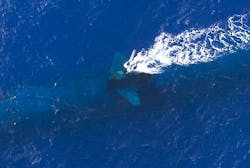Officials of the Naval Sea Systems Command in Washington are asking engineers at the Lockheed Martin Mission System sand Training segment in Manassas, Va., to provide Acoustics-Rapid COTS Insertion (A-RCI) submarine sonar systems production.
A-RCI is a sonar system that integrates and improves towed array, hull array, sphere array, and other ship sensor processing, through rapid insertion of commercial off-the-shelf (COTS) hardware and software, such as commercial blade servers.
The Navy is asking Lockheed Martin to develop and build the A-RCI and common acoustics processing for technology insertion 12 through technology insertion 14 for the Navy's submarine fleet. This contract modification provides for continued A-RCI Technology Insertion-14 hardware deliveries.
Related: Sonar technology comes to grips with dangerous new era
For the past 19 years Lockheed Martin sonar experts have been harvesting the most advanced and most promising COTS digital signal processing (DSP) equipment -- from embedded servers, field-programmable gate arrays (FPGAs), to powerful general-purpose processors) -- to achieve the most advanced submarine sonar signal processing at the most reasonable cost.
The A-RCI program is among the most visible U.S. military acknowledgements that COTS technology delivers the most capability at the least cost for defense-related embedded digital signal processing technology.
The A-RCI program, as its name suggests, seeks to move the latest COTS DSP technology into submarine signal processing systems aboard Virginia-, Seawolf-, and Los Angeles-class fast attack submarines, as well as aboard Ohio-class missile submarines on a regular basis to keep pace with commercial embedded computing developments.
A-RCI is an open-architecture sonar system that Navy officials intend to maintain an advantage in acoustic detection of threat submarines, using legacy sonar sensors. The program regularly refreshes central processors with COTS computer technology and software. A-RCI processors handle data from the submarine’s spherical array, hull array, wide aperture array, high-frequency arrays, and towed arrays.
Related: DARPA eyes bistatic sonar with UUV-based pingers to preserve stealth of attack submarines
An open-systems architecture makes the most of commercial processing development, and enables submarine signal processing systems to use complex algorithms that Navy-developed sonar systems such as the AN/BSY-1 and AN/BSY-2 systems cannot not use.
Using COTS technology enables onboard computing power to grow at nearly the same rate as commercial industry, and facilitates regular updates to submarine sonar-processing software and hardware with minimal disruption to submarine scheduling, Navy officials say.
On this contract modification Lockheed Martin will do the work in Manassas, Va., and Syracuse, N.Y.,, and should be finished by March 2019.
For more information contact Lockheed Martin Mission Systems and Training online at www.lockheedmartin.com/us/mst, or Naval Sea Systems Command at www.navsea.navy.mil.



